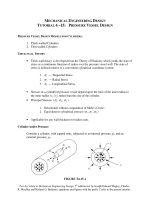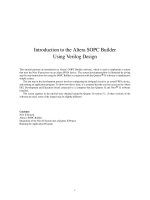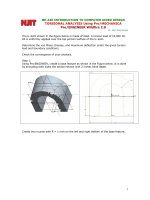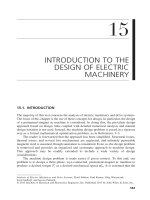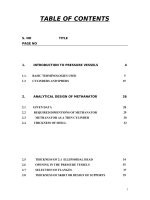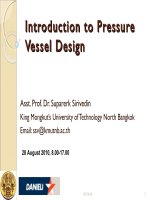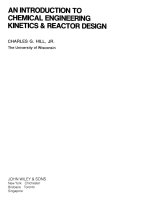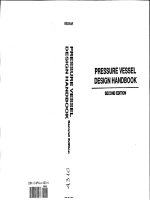Introduction to pressure vessel design
Bạn đang xem bản rút gọn của tài liệu. Xem và tải ngay bản đầy đủ của tài liệu tại đây (3.46 MB, 106 trang )
03/14/14 1
Introduction to Pressure
Introduction to Pressure
Vessel Design
Vessel Design
Asst. Prof. Dr. Suparerk Sirivedin
King Mongkut’s University of Technology North Bangkok
Email:
28 August 2010, 8.00-17.00
03/14/14 2
Training Outline
Training Outline
Principles of Pressure Vessel Design
Calculation of Pressure Vessel
Simplified ASME Codes in Pressure Vessel
Fitness for Service API 579
Failure Assessment Diagram
03/14/14 3
Principles of Pressure Vessel Design
Principles of Pressure Vessel Design
Typical pressure vessel Spherical pressure vessel
03/14/14 4
Horizontally supported pressure vessel
Principles of Pressure Vessel Design
Principles of Pressure Vessel Design
Horizontally supported pressure vessel consists of a cylindrical
main shell, with hemispherical headers and several nozzle connections.
03/14/14 5
Main components of pressure vessel
Principles of Pressure Vessel Design
Principles of Pressure Vessel Design
03/14/14 6
Pressurized water reactor (PWR) pressure vessel
Principles of Pressure Vessel Design
Principles of Pressure Vessel Design
03/14/14 7
Pressurized water reactor (PWR) pressurizer.
Principles of Pressure Vessel Design
Principles of Pressure Vessel Design
03/14/14 8
Principles of Pressure Vessel Design
Principles of Pressure Vessel Design
Design procedure
03/14/14 9
The organization of the ASME Boiler and Pressure Vessel Code is as follows:
Principles of Pressure Vessel Design
Principles of Pressure Vessel Design
1. Section I: Power Boilers
2. Section II: Material Specification:
i. Ferrous Material Specifications – Part A
ii. Non-ferrous Material Specifications – Part B
iii. Specifications for Welding Rods, Electrodes, and Filler Metals –Part C
iv. Properties – Part D
3. Section III Subsection NCA: General Requirements for Division 1and Division 2
i. Section III Division 1:
a. Subsection NA: General Requirements
b. Subsection NB: Class 1 Componentsc. Subsection NC: Class 2 Components
d. Subsection ND: Class 3 Components
e. Subsection NE: Class MC Components
f. Subsection NF: Component Supports
g. Subsection NG: Core Support Structures
h. Appendices: Code Case N-47 Class 1: Components in Elevated Temperature
Service
ii. Section III, Division 2: Codes for Concrete Reactor Vessel and Containment
03/14/14 10
4. Section IV: Rules for Construction of Heating Boilers
5. Section V: Non destructive Examinations
6. Section VI: Recommended Rules for the Care and Operation of
Heating Boilers
7. Section VII: Recommended Guidelines for Care of Power Boilers
8. Section VIII
i. Division 1: Pressure Vessels – Rules for Construction
ii. Division 2: Pressure Vessels – Alternative Rules
9. Section IX: Welding and Brazing Qualifications
10. Section X: Fiberglass-Reinforced Plastic Pressure Vessels
11. Section XI: Rules for In-Service Inspection of Nuclear Power Plant
Components
Principles of Pressure Vessel Design
Principles of Pressure Vessel Design
The organization of the ASME Boiler and Pressure Vessel Code is as follows:
03/14/14 11
Design and Construction Codes for Pressure Vessels
Principles of Pressure Vessel Design
Principles of Pressure Vessel Design
03/14/14 12
Structural and material considerations
Principles of Pressure Vessel Design
Principles of Pressure Vessel Design
•
Steels
•
Nonferrous materials such as aluminum and copper
•
Specialty metals such as titanium and zirconium
•
Nonmetallic materials, such as, plastic, composites and concrete
•
Metallic and nonmetallic protective coatings
The materials that are used in pressure vessel construction are:
The mechanical properties that generally are of interest are:
•
Yield strength
•
Ultimate strength
•
Reduction of area (a measure of ductility)
•
Fracture toughness
•
Resistance to corrosion
03/14/14 13
Principles of Pressure Vessel Design
Principles of Pressure Vessel Design
Mechanical loads on the pressure vessel include those due to:
•
Pressure
•
Dead weight
•
Seismic factors
•
Piping
In addition, snow and wind loadings should be considered wherever applicable.
Other loads due to various postulated accidents must also be considered.
The stress level is maintained below the allowable level, which is based on
consideration of many failures; for example, plastic collapse, fatigue, brittle fracture,
or buckling.
The modern view of the fatigue process is characterized by three main stages:
1. Fatigue crack initiation
2. Fatigue crack growth to a critical size
3. Failure of the net section.
03/14/14 14
Principles of Pressure Vessel Design
Principles of Pressure Vessel Design
where n
i
is the number of cycles at stress level i, and N
i
is the number of cycles to
failure at the same stress i. The ratio n
i
/N
i
is the incremental damage or the cycle
ratio, and it represents the fraction of the total life that each stress ratio uses up. If
the sum of all the different stress cycles (m) is less than unity the vessel is presumed
safe.
Tensile Test Fatigue Test
03/14/14 15
Factor of
safety
Principles of Pressure Vessel Design
Principles of Pressure Vessel Design
American Society of Mechanical Engineers (ASME) Boiler and Pressure Vessel
Code, Section VIII Division 1: ‘‘Rules for the Construction of Pressure Vessels,’’
used for establishing allowable stress values, advocates using the lesser of the
following:
•
25 % of the specified minimum tensile strength at room temperature
•
25 % of the tensile strength at design temperature
•
62.5 % of the specified minimum yield strength at room temperature
•
62.5 % of the yield strength at design temperature
•
Stress to produce 1 % creep strain in 100,000 hours at design temperature
•
80 % of the minimum stress required to produce material rupture, at the
end of 100,000 hours at design temperature
For a simple environment a criterion based entirely on yield strength seems
appropriate, therefore European pressure vessel construction codes typically
employ a factor of safety of 1.5 for the yield strength.
03/14/14 16
Design by rule
Principles of Pressure Vessel Design
Principles of Pressure Vessel Design
Design-by-rule methods were used in earlier ASME design codes
(Sections I and VIII).
Design-by-rule methods of design are based on experience and tests.
This process requires the determination of design loads, the choice of
a design formula and the selection of an appropriate stress allowable
for the material used.
The procedure provides the information on required vessel wall
thickness as well as the rules of fabrication and details of construction.
These rules do not typically address thermal stresses and fatigue. The
fatigue issues are considered covered by the factors of safety.
03/14/14 17
Principles of Pressure Vessel Design
Principles of Pressure Vessel Design
Design by analysis
The process involves detailed evaluation of actual stress including
thermal stresses and fatigue. This design approach provides a
rational safety margin (not unduly excessive) based on the actual
stress profile and optimizes design to conserve material, leading to
consistent reliability and safety.
Design-By-Analysis is appropriate for pressure vessels involving
cyclic operation and requiring superior reliability and safety, and is
suitable for pressure vessels for which periodic inspection is
deemed difficult (e.g., nuclear vessels). This viewpoint was first
incorporated into the ASME Boiler and Pressure Vessel Code
Section III and Section VIII Division 2 in 1968.
03/14/14 18
Theories of
failure
Principles of Pressure Vessel Design
Principles of Pressure Vessel Design
The most commonly used theories of failure are:
•
Maximum principal stress theory
•
Maximum shear stress theory
Maximum principal stress theory
According to the maximum principal stress theory, failure occurs when
one of the three principal stresses reaches a stress value of elastic limit
as determined from a uni-axial tension test. This theory is meaningful
for brittle fracture situations.
σ
1
>
σ
y
or
σ
2
>
σ
y
or
σ
3
>
σ
y
σ
1
,
σ
2
,
σ
3
= Principal Stresses
σ
y
= Yield Strength of Materials
03/14/14 19
Maximum Shear Stress Theory
The maximum shear stress is one half the difference between the
largest (say 1) and the smallest (say 3) principal stresses. This is also
known as the
Tresca
criterion, which states that yielding takes place
when
Principles of Pressure Vessel Design
Principles of Pressure Vessel Design
The distortion energy theory considers failure to have occurred when the
distortion energy accumulated in the component under stress reaches the elastic
limit as determined by the distortion energy in a uni-axial tension test. This is
also known as the
von Mises
criterion, which states that yielding will take
place when
03/14/14 20
Principles of Pressure Vessel Design
Principles of Pressure Vessel Design
03/14/14 21
Theories of failure used in ASME Boiler and Pressure Vessel Code
Principles of Pressure Vessel Design
Principles of Pressure Vessel Design
Two basic theories of failure are used in ASME Boiler and Pressure Vessel Code,
Section I, Section IV, Section III Division 1 (Subsections NC, ND, and NE), and
Section VIII Division 1 use the maximum principal stress theory.
Section III Division 1 (Subsection NB and the optional part of NC) and Section
VIII Division 2 use the maximum shear stress theory or the Tresca criterion.
The maximum principal stress theory (sometimes called Rankine theory) is
appropriate for materials such as cast iron at room temperature, and for mild
steels at temperatures below the nil ductility transition (NDT) temperature.
Although this theory is used in some design codes (as mentioned previously) the
reason is that of simplicity, in that it reduces the amount of analysis, although
often necessitating large factors of safety.
03/14/14 22
von Mises criterion
is better suited for common pressure vessels, the ASME
Code chose to use the
Tresca criterion
as a framework for the design by
analysis procedure for two reasons:
(a)it is more conservative,
(b)it is considered easier to apply.
However, now that computers are used for the calculations, the
von Mises
expression is a continuous function and is easily adapted for calculations,
whereas the
Tresca
expression is discontinuous.
Principles of Pressure Vessel Design
Principles of Pressure Vessel Design
In order to avoid dividing both the calculated and the yield stress by two, the
ASME Code defines new terms called stress intensity, and stress difference. The
stress differences (S
ij
) are simply the algebraic differences of the principal
stresses
σ
1
,
σ
2
,
σ
3
03/14/14 23
Principles of Pressure Vessel Design
Principles of Pressure Vessel Design
The stress intensity, S, is the maximum absolute value of the
stress difference
In terms of the stress intensity, S,
Tresca criterion
then
reduces to
Throughout the design by analysis procedure in the ASME
Code stress intensities are used.
03/14/14 24
Allowable stress limits in the ASME Boiler and Pressure Vessel Code
Principles of Pressure Vessel Design
Principles of Pressure Vessel Design
The overall objective in determining the allowable stress limits is to
ensure that a pressure vessel does not fail within its established design
life. The modes that are most likely to cause a failure, as identified by
the ASME Code, are as follows:
•
Excessive elastic deformation including elastic instability
•
Excessive plastic deformation
•
Brittle fracture
•
Stress rupture or creep deformation (inelastic)
•
Plastic instability and incremental collapse
•
High strain and low cycle fatigue
•
Stress corrosion
•
Corrosion fatigue
03/14/14 25
The allowable stress limits in the ASME Code are established on
two modes of failure and are characterized as:
Principles of Pressure Vessel Design
Principles of Pressure Vessel Design
•
Avoidance of gross distortion or bursting
•
Avoidance of ratcheting
The primary mean stresses (or primary membrane stresses),
P
m
, represent the
sustained load acting on the structure divided by the cross-sectional area
resisting the load. In fact
P
m
is the stress intensity derived from the stress
distribution and as such is the difference between the largest and the
smallest of the principal stresses.
P
m
determines the susceptibility of the
structure to fail by plastic collapse.
For an elastic–perfectly plastic stress strain law such a vessel would be fully
plastic when the membrane stress reaches the yield stress. A safety factor of 1.5
is provided. The allowable design stress (primary membrane) is therefore
limited to a stress limit typically of the yield (referred to as material
allowable
S
m
).
3
2
